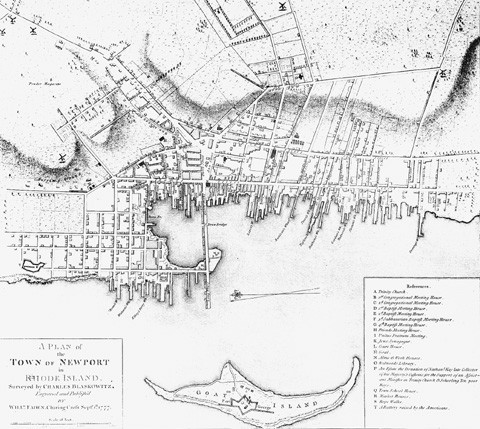
Map of Newport, Rhode Island, Charles Blaskowitz, surveyor, for the British Admiralty, 1777. Paper. Dimensions not recorded. (Courtesy, Newport Historical Society.)
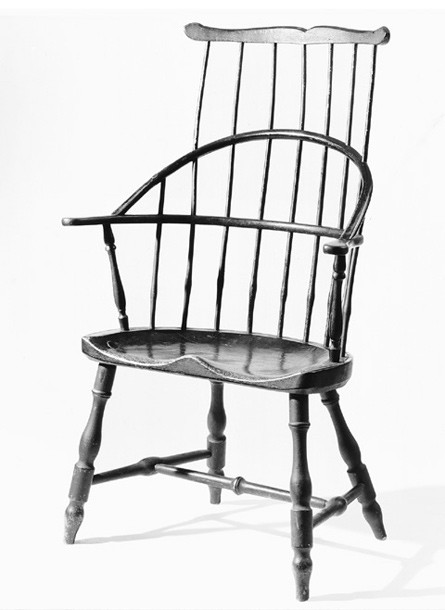
Sack-back Windsor armchair with back extension, probably Providence, Rhode Island, 1780–1785. Chestnut (seat) with maple and oak. H. 43 7/8", W. 28" (arms), D. 14 1/4". (Private collection; photo, Winterthur Museum.)

Fan-back Windsor side chair, Rhode Island, 1780–1790. Probably yellow poplar (seat) with maple and oak. H. 37 1/2", W. 20 1/8" (crest), D. 15 7/8". (Thomas B. Rentsehler collection; photo, Winterthur Museum.)
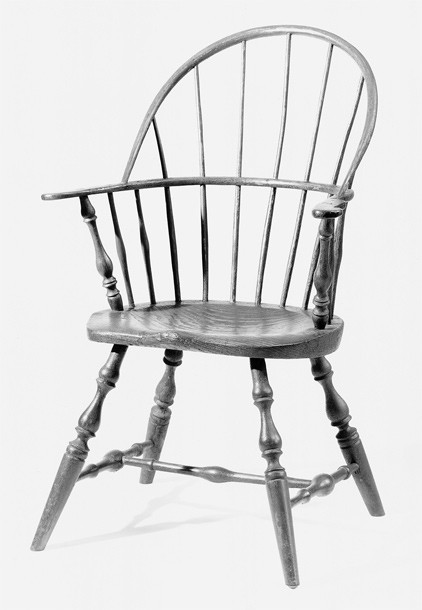
Sack-back Windsor armchair, Ebenezer Tracy, Sr., Lisbon Township, New London County, Connecticut, ca. 1787–1795. Chestnut (seat) with maple and other woods. H. 37 1/2", W. 25" (arms), D. 15 1/2". (Private collection; photo, Winterthur Museum.)
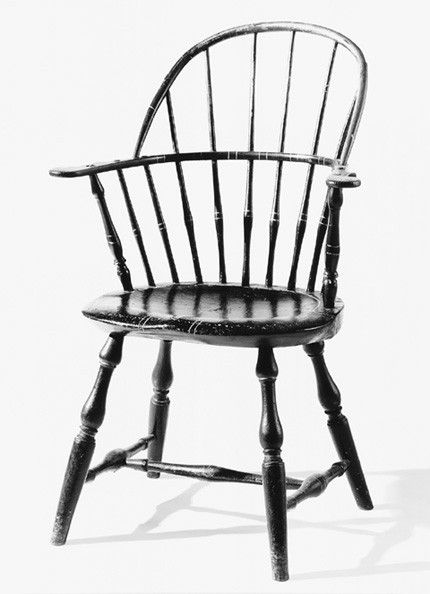
Sack-back Windsor armchair, eastern Connecticut, 1790–1800. Probably yellow poplar (seat) with maple and oak. H. 36 1/4", W. 24 5/8" (arms), D. 16". (Courtesy, Connecticut Historical Society; photo, Winterthur Museum.)
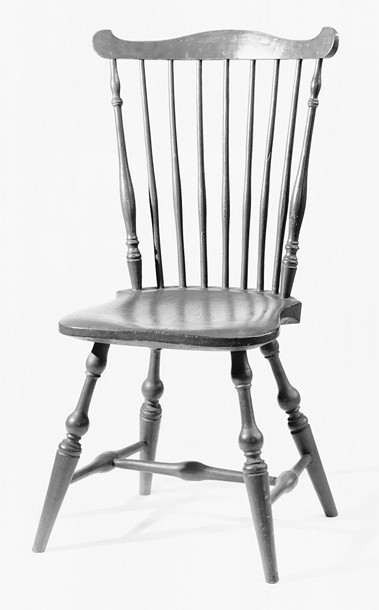
Fan-back Windsor side chair, Elijah Tracy, Lisbon Township, New London County, Connecticut, ca. 1787–1795. Chestnut (seat). H. 37 3/8", W. 20 1/4" (crest), D. 16 3/4". (Private collection; photo, Winterthur Museum.)
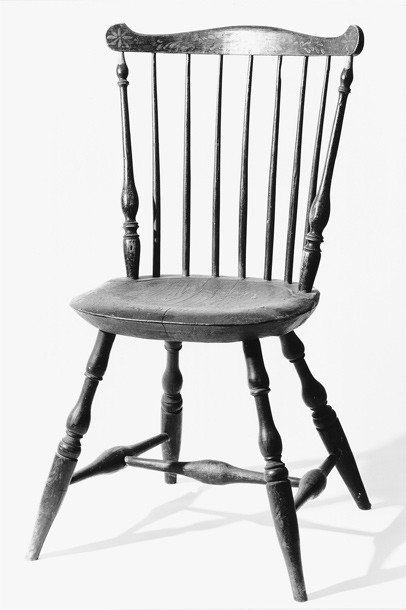
Fan-back Windsor side chair, Connecticut–Rhode Island border region, 1790–1800. Pine (seat) with maple, oak, and ash. H. 34 1/2", W. 20 5/8" (crest), D. 15 3/8". (Courtesy, University of Rhode Island; photo, Winterthur Museum.)
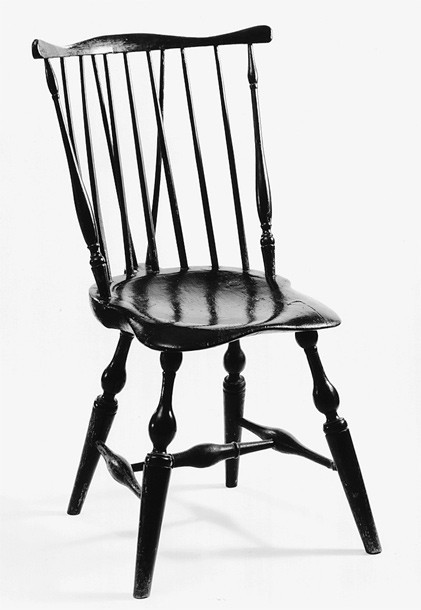
Fan-back Windsor side chair, attributed to Samuel Hemenway, Shoreham, Vermont, ca. 1792–1800. Basswood (seat, microanalysis).
H. 34 1/4", W. 20 3/4" (seat), D. 16". (Private collection; photo, Winterthur Museum.)
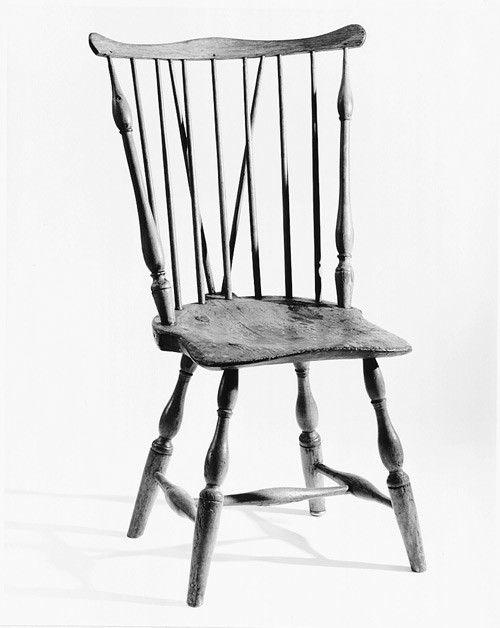
Fan-back Windsor side chair, central Vermont, ca. 1794–1800. Maple, oak, and other woods. H. 36 1/4", W. 21 7/8" (crest), D. 16 1/4". (Steven and Helen Kellogg collection; photo, Winterthur Museum.)

Sack-back Windsor armchair, Rhode Island, 1785–1800. Maple (seat) with white oak, ash, and hickory (microanalysis). H. 27 3/4", W. 22 1/2" (arms), D. 22 1/4" (legs). (Courtesy, Museum of Fine Arts, Houston, Bayou Bend Collection, gift of Miss Ima Hogg.)
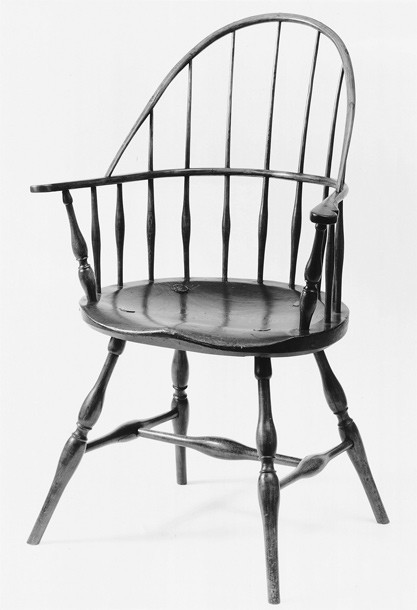
Sack-back Windsor armchair, Connecticut–Rhode Island border region, 1792–1800. Probably pine (seat) with maple, oak, and ash. H. 38 5/8", W. 24 5/8" (arms), D. 16 1/2". (Mary Means Huber collection; photo, Winterthur Museum.)

Sack-back Windsor armchair, Connecticut–Rhode Island border region, 1790–1800. Probably pine (seat). H. 36 3/4", W. 23 3/4" (arms), D. 16 3/8". (Courtesy, Danbury Museum and Historical Society, Danbury, Connecticut.)

Fan-back Windsor side chair, Rhode Island, 1780–1790. Maple (seat). Dimensions unknown. (Private collection.)
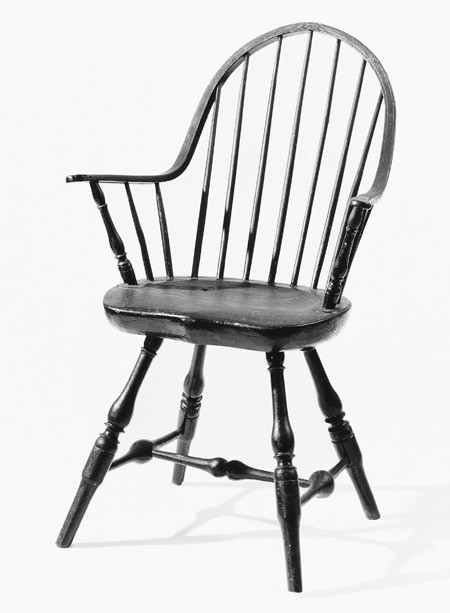
Continuous-bow Windsor armchair, probably northern Vermont, 1795–1805. Woods not recorded. H. 36 3/8", W. 23 7/8" (arms), D. 15 1/4". (Courtesy, Orleans County Historical Society, Brownington, Vermont; photo, Winterthur Museum.)

Sack-back Windsor armchair, southeastern New Hampshire, 1790–1800. White pine (seat) with maple, ash, red oak, and white oak (microanalysis). H. 38 1/4", W. 23 1/2" (arms), D. 20 1/4" (legs). (Courtesy, Museum of Fine Arts, Houston, Bayou Bend Collection, gift of Miss Ima Hogg.)
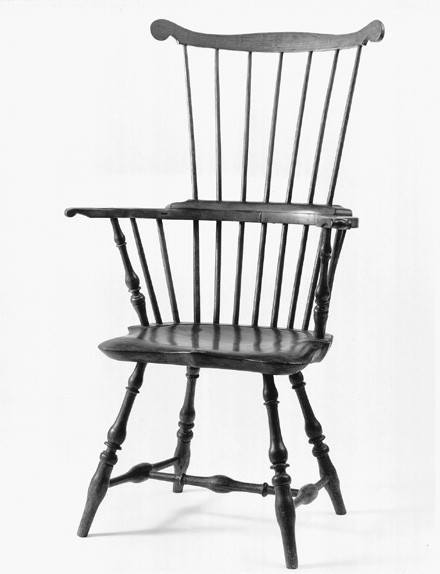
High-back Windsor armchair, Rhode Island, 1790–1800. Maple, ash, oak, and other woods. H. 43 1/8", W. 26 1/4" (arms), D. 14 3/4". (Courtesy, Memorial Hall Museum, Pocumtuck Valley Memorial Association, Deerfield, Massachusetts; photo, Winterthur Museum.)
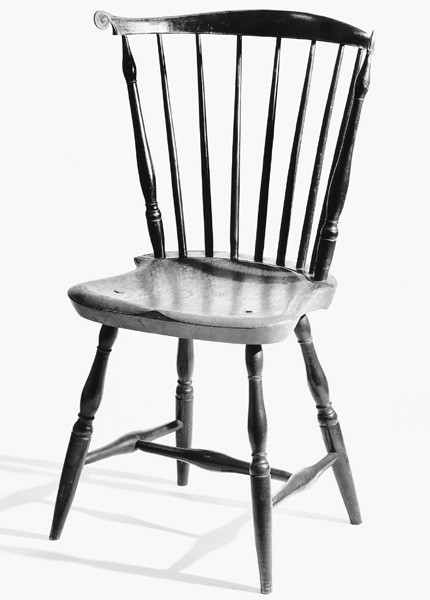
Fan-back Windsor side chair, southeastern Rhode Island at the Massachusetts border, 1790–1805. Probably yellow poplar (seat) with maple and oak. H. 35 5/8", W. 22 1/8" (crest), D. 16 7/8". (Courtesy, Newport Historical Society; photo, Winterthur Museum.)
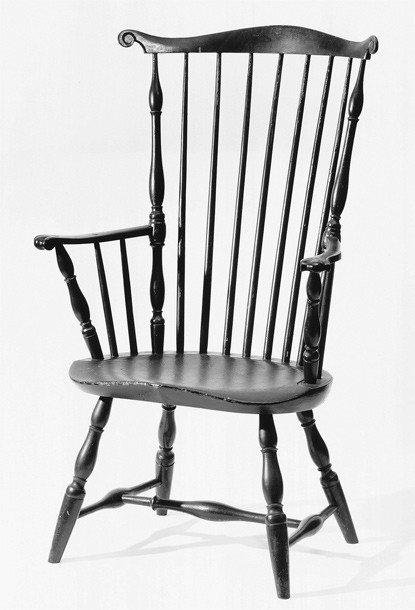
High-back Windsor armchair, Plymouth or Bristol counties, Massachusetts, 1795–1805. Probably pine (seat), with oak and other woods. H. 41", W. 26" (arms), D. 15 3/4". (Private collection, on loan to Society for the Preservation of New England Antiquities; photo, Winterthur Museum.)
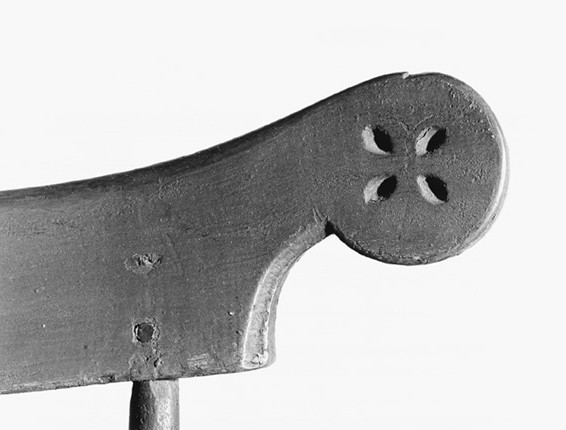
Crest detail of high-back Windsor writing-arm chair, southeastern Massachusetts, probably Norfolk County, 1790–1805. Woods not recorded. H. 38", W. 20 3/8" (seat), D. 15 1/4". (Courtesy, Peabody Essex Museum; photo, Winterthur Museum.)
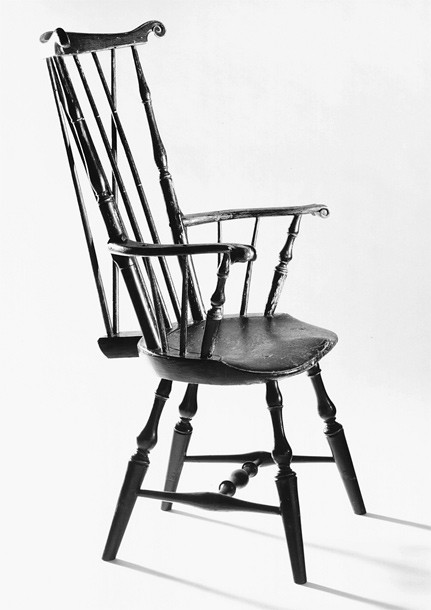
High-back Windsor armchair, Charles Chase, Nantucket, Massachusetts, 1790–1805. White pine (seat) with birch, ash, and oak (microanalysis). H. 42 3/4", W. 27 3/8" (arms), D. 15 7/8". (Courtesy, Winterthur Museum.)
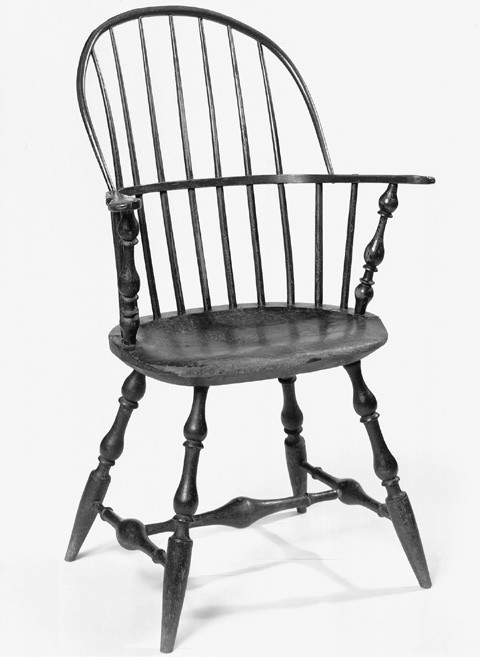
Sack-back Windsor armchair, Rhode Island, 1785–1795. Chestnut (seat) with other woods. H. 42 1/2", W. 20 1/2", D. 15 1/4". (Courtesy, Old Sturbridge Village.)
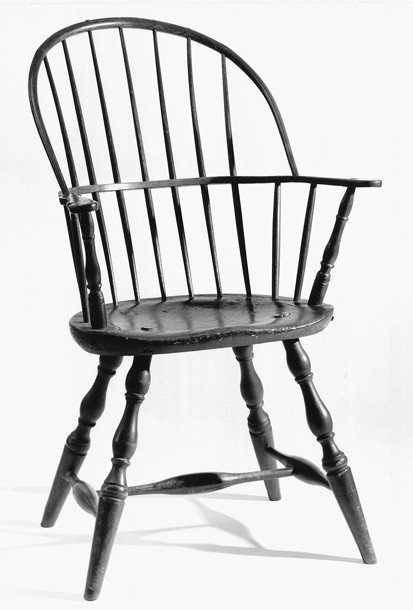
Sack-back Windsor armchair, Connecticut–Rhode Island border region, 1790–1800. Maple, oak, and other woods. H. 37 1/2", W. 24 3/8" (arms), D. 12 7/8". (Steven and Helen Kellogg collection; photo, Winterthur Museum.)
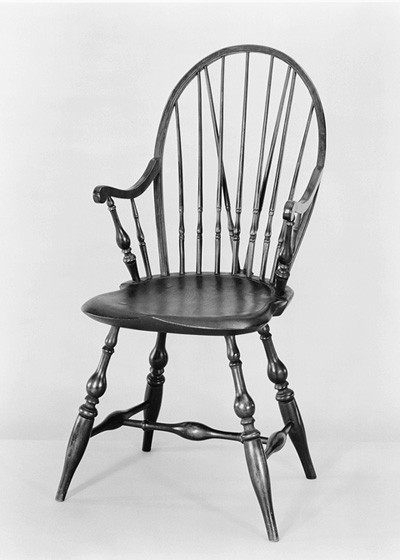
Bow-back Windsor armchair, Rhode Island, probably Providence, 1790–1800. White pine (seat) with maple, ash, and mahogany (arms). H. 38 3/8", W. 17 1/8", D. 19 3/4". (Courtesy, Colonial Williamsburg Foundation.)
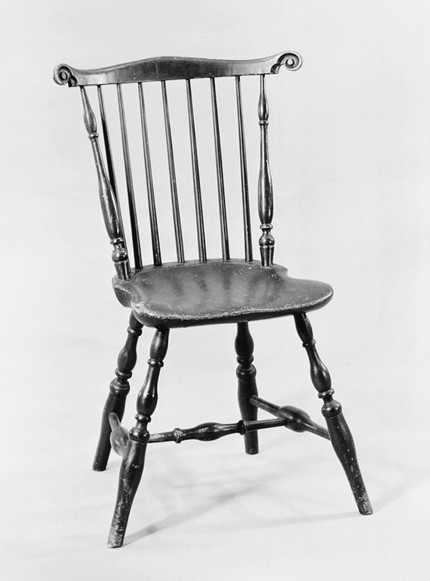
Fan-back Windsor side chair, Boston, Massachusetts, ca. 1793–1798. White pine (seat) with maple and hickory. H. 35 1/4", W. 17 3/8", D. 16 3/8". (Courtesy, Colonial Williamsburg Foundation.)
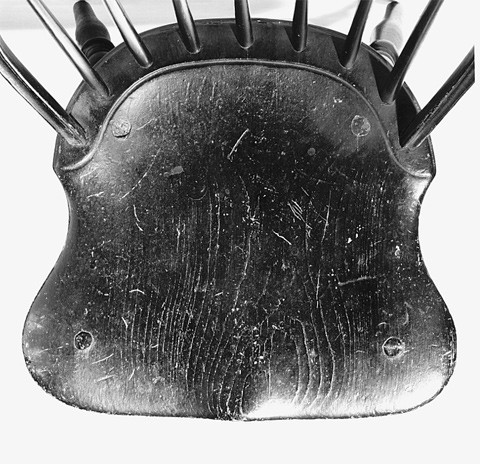
Seat detail of a bow-back Windsor side chair by William Seaver, Boston, Massachusetts, 1795–1800. White pine (seat) with birch (microanalysis) and other woods. H. 37 3/8", W. 17 1/2", D. 16 1/8". (Private collection; photo, Winterthur Museum.)
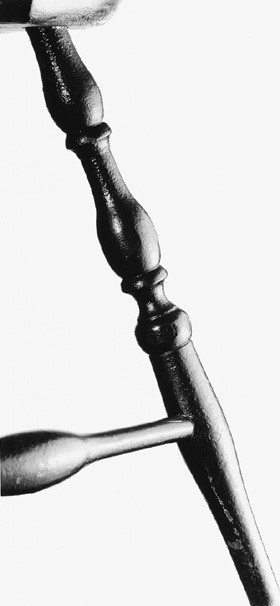
Detail of a leg from the bow-back Windsor side chair illustrated in fig. 25.
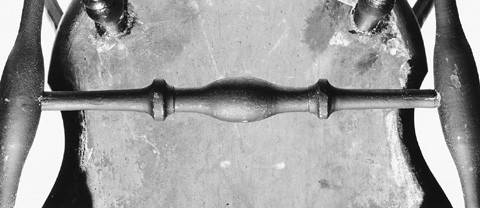
Detail of the medial stretcher from the bow-back Windsor side chair illustrated in fig. 25.
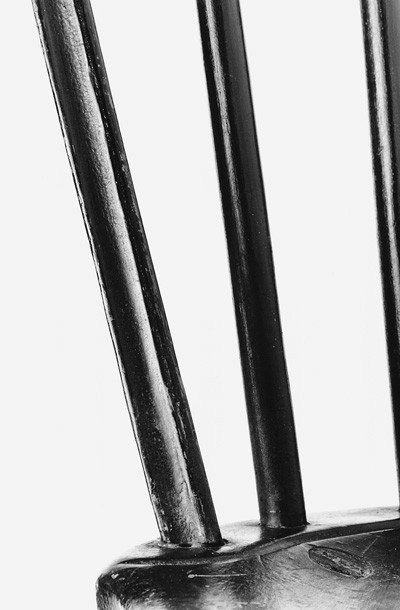
Detail of the bow face from the bow-back Windsor side chair illustrated in fig. 25.
The third quarter of the eighteenth century has been called the golden age of Newport, the commercial center of New England in the late colonial period. Conditions changed in December 1776 when British troops occupied the city and its environs and remained almost three years. The devastation and destruction of the war years was followed by upheavals in the economic and political life of Rhode Island, conditions that prevailed into the early 1790s. The unsettled nature of the 1780s is visually documented in the products of the Windsor chairmaking shops that dotted the region. The chairs of sack-back and fan-back pattern common to this decade, supplemented by a small number of high-back chairs, exhibit considerable diversity in their turned, sawed, and shaved elements. Heterogeneity of production rather than homogeneity was the rule of the day. Besides influencing area markets, Rhode Island furniture of the 1780s and later had a substantial impact on chairmaking throughout New England. The reason can be summed up in two words: commercial enterprise. To stay afloat during the troubled times, Rhode Island chairmakers, aided by a group of equally venturesome traders and shipowners, conducted business well beyond their own geographic boundaries. As a result, idiosyncrasies of Rhode Island design frequently interacted with or directed chairmaking activity in other areas.
Newport, Rhode Island, was the first center of Windsor chairmaking in New England. Evidence supports craft activity by the early 1760s, a period when the colony reached its peak as a maritime leader and seamen comprised perhaps as much as 25 percent of the work force. On a typical day the wharves at Newport were crowded with shipping (fig. 1). In a trading economy largely sustained by barter and bills of exchange, Rhode Island merchants and small independent mariners drew their exports or trading goods from farmers and dairymen over a broad area: the towns, villages, and landings surrounding Narragansett Bay; the border counties of eastern Connecticut; and parts of the Massachusetts counties of Bristol, Plymouth, Norfolk, and Worcester, lying to the north and east of the colony. These were the trading areas craftsmen, teamsters, and coastal shippers looked to again when rebuilding their lives after the Revolution.[1]
When the British evacuated Newport in 1779, the seaport was a mere shell of its former self. Hundreds of houses had been destroyed; others were falling to ruin. At least two-fifths of the residents had fled, and those who remained suffered from a lack of fuel and provisions. The British had appropriated the wharves, fences, forests, and orchards for fuel and slaughtered the livestock to feed the troops. With Newport harbor blockaded for several years and its trade at a standstill, Providence had become the new commercial center of Rhode Island. As a final affront to the community, the British carried off the town records. During a visit in 1784, Latin American soldier-adventurer Francisco de Miranda found the community in a “miserable” state. This condition appeared only modestly improved when English traveler Issac Weld visited Newport in 1795.[2]
Rhode Island and its citizens were heavily in debt at the end of the Revolutionary War. The once highly lucrative trade with the West Indies was on the decline due to changing political conditions in Europe and growing unrest in Europe’s Caribbean colonies. The slave trade, which once contributed to the prosperity of the colony, was abolished after the war by an act of the legislature. An emission of paper money, effected by the state in May 1786 as a stimulus to the economy and as a means of recovery from debt, was seen by some as a boon and by others as an evil. The currency rapidly depreciated. Recalling his visit to Rhode Island in 1788, J. P. Brissot de Warville commented, “I seemed to perceive everywhere the silence of death, the effect of paper-money.” A year later, geographer Jedidiah Morse described “the iniquitous and destructive influence of paper money,” as debts were discharged at a fraction of their face value. Some traders packed up their goods and left; others closed their shops. Olney Winsor of Providence, who had advertised as a shopkeeper in 1782, moved temporarily in 1786 to Alexandria, Virginia, where he acted as agent for a Providence merchant house. In October he wrote home to his wife informing her that he was optimistic about the success of the venture, “if we do not suffer very largely by the destructive Politicks of Rhode Island.”[3]
The sweeping effect of the paper money emission and a subsequent act, which forced creditors to accept currency at face value, came to a head in 1786 when Providence householders were unable to procure “the Necessaries of Life” at the town market. The freemen of the town issued a public plea urging “that the Inhabitants of the Vicinity, such as usually frequent this Market, be earnestly requested to attend to the distressed Situation of the Town, and to furnish such necessary Supplies as may be in their Power.” The act creating the paper money system remained in force until October 1789.[4]
Meanwhile, a national convention had convened at Philadelphia in May 1787, with delegates in attendance from all states except independent-spirited Rhode Island. By year’s end three states had ratified the new federal constitution. Rhode Island, however, held out until May 1790, during which time the state legislature balked thirteen times on the question of adopting a resolution in favor of ratification. In the end the reality of economic conditions, described in an issue of the Providence Gazette, turned the tide:
We stand perfectly alone, unconnected with any State or Sovereignty on earth. . . . Our commerce and navigation are deprived of national protection. . . . All trade with the new Confederated States will probably soon be interdicted . . . , except on the footing of foreigners, and of course on the payment of exorbitant duties. . . . Our commerce and navigation, already extremely embarrassed, must be annihilated; and the ports of the State of Rhode-Island, which but a few years since were crowded with shipping, will afford shelter to a few fishing craft. The loss of our commerce will inevitably be attended with the most ruinous consequences to agriculture and manufactures.
In summary, the economic climate of Rhode Island during the 1780s was unfavorable to the pursuit of business with any degree of regularity or with any reasonable assurance of success.[5]
The first Windsor chairs produced in postwar Rhode Island are in a large measure a reflection of prewar design. Some features remained unchanged, others were updated, and a few were newly introduced. The chair illustrated in figure 2 serves as an excellent “vocabulary” piece, describing a variety of Windsor design and construction options in the early federal marketplace. Notable is the small swelling, or nodule, located in the lower part of the spindles, a distinctive new feature that became almost a trademark of Rhode Island and Rhode Island–influenced design. The sculptural quality of the prewar chair was enhanced, sometimes to the point of exaggeration, in some of the finest modeled seats of the 1780s. As demonstrated in the illustrated example, a deep well, defined across the front by a vigorous double sweep flanking a large pommel, which is sometimes marked by a crease, provides comfort and design interest. A broad chamfer along the bottom edge further relieves the visual bulkiness of the two-inch-thick plank. As exhibited in many examples of Rhode Island work produced during the 1780s, the carved groove that usually marks the forward edge of the spindle platform adjacent to the well is absent. The leg turnings, based generally on an English prototype, have been updated from prewar days with a more stylish foot and a shorter, well-defined baluster having a flaring, collarless head. Stretchers precisely defined by a central ball or disk are an accompaniment to this pattern. Two recurring features of Rhode Island production absent from the chair shown in figure 2 are tipped stretchers and leg turnings socketed internally. Here, the leg tips are exposed on the plank surface.[6]
Providence appears to be the origin of the armchair illustrated in figure2, based on the recovery of other examples in the area and the descent of a pair of chairs in the family of John Brown, the city’s preeminent merchant in the late eighteenth century. Chestnut seats are common on chairs from Rhode Island and eastern Connecticut but rare on seating made outside that area. A distinctive feature of this chair is the pronounced neck at the base of the baluster turning on the legs. Although of limited occurrence, the feature migrated well beyond the borders of Rhode Island. In particular, the necked baluster can be associated with craftsmen in eastern Connecticut and Vermont. Sometimes the feature is present in all the turned work of a chair. At other times it is confined to the upper or lower structure alone. Baluster profiles are variable, and a changing mixture of other features is the norm.[7]
A distinctive interpretation of the necked-base baluster probably was produced wholly in Rhode Island (fig. 3), although one example has an early history in an adjacent Connecticut border town and could have been produced in that area. The common feature of the group is an unusual double-ended baluster of swelled form, as illustrated in the back posts. This turning, like the baluster in the undercarriage of the chair shown in figure 2, probably derives in general character from prewar prototypes. Ordinarily the profile of the double-ended baluster is repeated in the undercarriage. This chair is an exception, although the baluster of the legs retains a necked base. Several other features typical of Rhode Island Windsors are present on the chair shown in figure 3; however, these particular details do not always occur together: internally socketed legs, a spindle platform lacking a groove on the forward surface, and a deep chamfer below the vertical edge of the seat back. Spindles that slim noticeably at both ends (see fig. 3) appear with regularity in the production of the Connecticut–Rhode Island border region. A bow-back side chair belonging to this necked-baluster group has a history of ownership by Reverend Noadiah Russel, minister of the Congregational Church of Thompson, Connecticut, as recorded in 1912 when presented to the church. Federal census records confirm that an individual of this name was a resident of the town from at least 1790 to 1810.[8]
The best-known Windsor production bearing the necked-base baluster is that of the Tracy family of Lisbon Township, New London County, near Norwich, Connecticut (fig. 4). The family’s distinctive formulaic design for a sack-back chair, one of several Windsor patterns these craftsmen produced, includes a necked-base baluster in the roundwork of the arm posts, a profile not unlike that in the leg balusters of the chair illustrated in figure 2. The necked-baluster feature is absent from the leg turnings, although compatibility is achieved through the presence of a flared head in all the balusters and adjacent spool turnings. The large size of the spools in the legs is noteworthy because Rhode Island work is again the source. The tipped stretchers strengthen that bond. In accordance with regional preference, chestnut was the wood selected for the seat.[9]
The oval became the common profile of the sack-back chair seat. In Tracy family production, the front corners of the plank have an angular character, the legs regularly socket internally, and a groove to define the spindle platform is a rare feature. The prominent pommel at the center front is still another reminder of the family’s substantial debt to Rhode Island design, an obligation echoed again in the use of nodular spindles. Despite these extensive borrowings, the Tracy craftsmen created a distinctive design, which is generally identifiable even when undocumented.
The seat bottom of the armchair shown in figure 4 bears the brand of Ebenezer Tracy, Sr., patriarch of the family. The chair dates fairly early in the craftsman’s career, since the “Y” in the surname on the brand is intact, having yet to sustain the damage to the right arm apparent in later strikes. The Tracys were reasonably successful in their production of Windsor furniture, as attested by the large number of chairs that survive and their many imitators.
Two sack-back chairs that interrelate with Tracy family work, one of close design and perhaps made by them, have similar histories in the town of Scotland, a community about a dozen miles overland from the Tracy homestead and shops (fig. 5). The chairs were acquired in 1898 or earlier from one Nathan Fuller by the mother of the last private owner. Federal censuses record a Nathan Fuller in the adjacent town of Windham between 1790 and 1850, along with a Nathan, Jr., in 1850.[10]
The second of the two Fuller family chairs (fig. 5) deviates significantly from Tracy work in the shape and profile of its features, but there are common threads, demonstrating how idiosyncrasies of design from an original source were perpetuated through intermediates, such as the Tracys. The principal bond between the chairs illustrated in figures 4 and5 is the design of the arm posts. The same elements occur, although they are simply less flamboyant in the latter chair (fig. 5). The baluster is elongated and slimmed, with only token necking at the base. Likewise, the flare at the tops of all the balusters is almost imperceptible. By contrast, there is close conformity in the stretchers of the two chairs and in the mitten-like profiles of the arm terminals. Although the planks deviate appreciably in modeling across the front, the chair shown in figure 5 retains several Rhode Island characteristics present in the Tracy chair: internally socketed legs, a grooveless spindle platform (here simulated with paint in the late nineteenth century), a deep seat well, and a prominent pommel. The bold flare at the base of the spindles (fig. 5) may be noted elsewhere in southern Connecticut work. Examples range from two produced in New London County, one with features close to the documented work of Elisha Swan of Stonington, to a chair labeled by Joseph Birdsey, Jr., of Huntington, a community located inland from Bridgeport.[11]
The Tracy craftsmen took advantage of the Rhode Island necked-base baluster feature in another production Windsor, the fan-back side chair (fig. 6). The back posts, like the arm posts in the sack-back chair, are distinctive, and the design had substantial impact on area chairmaking, judging by the number of variants encountered today. Again, most chair planks have visually plain top surfaces, lacking any evidence of leg sockets or the traditional groove defining the spindle platform. The Tracy craftsmen modeled the forward edge of the shield-shaped plank, which is common to the Windsor side chair, in several patterns. One has a pronounced central pommel. A chair with the brand of Elijah Tracy, Ebenezer’s eldest son, has a distinctive, flattened, ribbonlike edge (fig. 6). The Tracys used a standard collared baluster for the legs of their side chairs, and tipped stretchers are a variable feature. Crest ends are divided between a rounded terminal and the “hook” type of this chair, a pattern of Rhode Island origin but with roots in joined seating furniture.[12]
A hook-type crest piece and Tracy-style back posts with rounded bases are the distinctive features of a related fan-back chair made in the Connecticut–Rhode Island border region (fig. 7). The thick pine seat with minimal surface modeling denotes a rural origin. A carved groove defines the spindle platform; however, the legs are socketed internally. Two elements in the legs are compatible with Tracy styling. The spool turning relates to that in the fan-back chair (fig. 6), and the somewhat lumpy top element is close in profile to that shown in figure 4. The tapered toes in the feet of the border chair fall outside the vocabulary of Tracy styling.
The fan-back chair illustrated in figure 8 represents a substantial departure from the Windsor styling associated with the Tracy family and their imitators. The necked-base feature occurs in the legs below full-bodied balusters. One of a small group of Windsors of several patterns related through the turnings and the mannered styling of the seat front, this chair is attributed to Samuel Hemenway, in whose family some related examples descended. Hemenway resided east of Worcester in the communities of Grafton and Shrewsbury, Massachusetts, before emigrating in 1792 to Shoreham, Vermont, on Lake Champlain to join other family members. At this date Grafton and Shrewsbury were agricultural towns, each located on the Blackstone River, which passes into Rhode Island and becomes the Pawtucket River before emptying into the Providence River and Narragansett Bay. The area was part of the hinterlands that supported Rhode Island’s coastal trade. This close connection of local agricultural producers with the Rhode Island commodities market likely explains the heavy Rhode Island influence in Hemenway’s design, which probably extends to the crest piece with its ruler-straight bottom edge and spare form.[13]
Hemenway’s known production appears associated with Vermont rather than Massachusetts. The family furniture was made for a niece in Vermont, and another fan-back chair bears the ink inscription, “Very old/originally belonged to/Mrs. Meech./Monkton, Vt.” The seats of Hemenway’s chairs are made of basswood, a material found in other chair production of the Champlain region. Like the Tracy family, Hemenway had his imitators. A sack-back chair has similar full-bodied, necked-base baluster legs, and the seat front exhibits a slight arch, or “hollow,” beneath the pommel in the manner of the fan-back chair. The sack-back chair, which is in an institutional collection in Vermont, was owned originally by Daniel Newton of Shoreham, who migrated from Shrewsbury. The chair eventually came into the possession of Silas Hemenway Jenison, a friend and neighbor. Supporting this tradition are federal census records for Vermont, which list a Daniel Newton in Shoreham in 1800, 1810, and 1830 and a Silas H. Jenison at that place in 1830 and 1840. In 1820 the two men were residents of Bridport, a neighboring town.[14]
A second chair, one of continuous-bow pattern, is said to have been used on the lake steamer Vermont, placed in service in 1809. The chair has slimmer turnings than those shown in figure 8 and double-tapered, or toed, feet. The fan-back chair illustrated in figure 9 also bears an obvious relationship to Hemenway’s work, as indicated in the clipped quality of the crest, the use of bracing spindles—an uncommon feature in the fan-back pattern—the droop and hollow pommel of the seat front, and the leg balusters with their simulated necked bases. The balusters are actually fitted with a tight collar at the base that gives the appearance of a slim neck.[15]
Another distinctive stylistic feature of Rhode Island origin, and one of broad influence in Windsor chairmaking, is a turning that consists of two balusters positioned end-to-end and usually separated by a small element, ranging from a spool to a disk (fig. 10). The feature occurs as a medial stretcher, legs, or posts, sometimes as a single unit, although often as a combination of several units. Many chairs constructed with turned work of this form have one or more aberrant or otherwise unusual features also incorporated into their design. Consequently, most chairs are one of a kind or at best represent the limited production of one shop.
The double-baluster turning was already a well-known feature with a long history in furniture design when introduced to Windsor construction. Stretchers in woven-bottom seating furniture dating from the early eighteenth century, particularly banister-back and fiddle-back chairs, are frequently embellished with double balusters, and a few couches and roundabout chairs have similar braces. Turned tables of the same period with straight, splay, or gate legs are often supported on double-baluster roundwork. The earliest New England Windsors fitted with double-baluster turnings were made in Rhode Island. All have high backs and date to the immediate prewar years. The use of double balusters in Rhode Island Windsor work may also reflect some influence from high-style English Windsors in the colonial market. The profile continued in use into the early nineteenth century, when the term “Cumberland” identified double-baluster turnings whose function was principally that of a front stretcher and long or short spindles in the backs of slat-style Windsors.[16]
The most aesthetically successful double-baluster profile in Windsor seating is one with a flared-spool center (fig. 10). Sack-backs and fan-backs are the common chair patterns, and chestnut and maple planks occur in sufficient numbers to reinforce the Rhode Island origin. Maple was a popular choice for seat planks among Rhode Island chairmakers in the prewar years, although the material largely fell out of use for seats after the Revolution, when yellow poplar and pine provided alternative choices in supplement to chestnut.
The chair illustrated in figure 10 has a vigorously modeled maple seat and a slightly bulging bow profile, both prominent characteristics of postwar Rhode Island Windsor work. Sounding a note of discord, however, is the introduction of large spool-and-ball turnings to the legs and posts. The size and design of these elements interrupt the smooth flow of the roundwork from top to bottom. In some examples the variation from standard features is even more pronounced.[17]
Complementing this example (fig. 10) is a fan-back side chair with identical spool and ring turnings in the legs and back posts. The side chair is unusual in having an especially broad shield-shaped seat and back posts dominated by an extra long, tear-shaped element at the top. Two related side chairs have similar seats and posts, although their leg turnings are of standard form. One is said to have been owned and used by Franklin Pierce (1804–1869), fourteenth president of the United States, at his Hillsborough, New Hampshire, home, where the chair was sold in 1926. The chair could have been purchased new by Pierce’s father, Benjamin, who served two terms as governor of New Hampshire, or as secondhand furniture when young Franklin studied law at Portsmouth. The active coastal trade out of Rhode Island could have placed the chair in Portsmouth decades earlier.[18]
The double-baluster-and-spool turning became a more prominent design feature when repositioned as a vertical support, as illustrated by the chair shown in figure 11, which is representative of a small group of Windsors with a Rhode Island orientation. At least four chairs—three sack-backs and one fan-back (from a set of three)—are sufficiently close in design to suggest they came from one shop. The chairs share several design and construction features. The bow arch in all three chairs is high and pointed. The arm rails terminate in grips sawed to the same profile—a circular pad followed by a wavy side piece. The plank tops of all four chairs are pierced by the legs, and the platforms forward of the nodular spindles are without a defining groove. A deep chamfer finishes the vertical plank edges at the bottom (confined to the back in the side chair), and a prominent pommel marks the center front. A curious construction feature, which deviates from standard practice, sockets the arm posts and back posts inside the plank. Two armchairs, including the example illustrated in figure 11, also have laying out marks on the plank bottom to guide the chairmaker in positioning the leg sockets, or mortises. The legs of this chair and the fan-back chair lack a defining collar in the upper baluster at the juncture with the top element, introducing an abrupt transition between the two. The remaining armchairs have a large compressed-ball turning at this point, which produces about the same visual effect.[19]
The armchair shown in figure 11 and its three mates were products of a rural tradesman serving a local clientele, probably along the northern boundary between Rhode Island and Connecticut. Two chairs have histories in that region. The illustrated Windsor descended in the Crosby family of Thompson, Connecticut, a town about four miles west of the border. Stephen Crosby (1772–1849; married 1792) is first listed in Thompson in the federal census of 1800. He was a son of Captain Stephen I., who was killed during the Revolutionary War. One armchair with the ball turning near the leg tops descended in the Sumner family of neighboring Pomfret. Listings for family members in the community appear as early as the first federal census in 1790.[20]
Whereas the group of chairs represented by the example illustrated in figure 11 can be considered somewhat eccentric in turned feature and construction, the chair shown in figure 12 represents a small group of Windsors of truly aberrant design. With its double-baluster-and-spool-turned legs, this chair clearly relates to the one illustrated in figure 11. The unequal dimensions of the leg balusters, the direct connection of the upper baluster with the plank, and the simple profile of the arm posts suggest the work of a handyman rather than that of a trained chairmaker. The seat follows the plan of that shown in figure 11, with the addition of a prominent ridge on the forward edge of the pommel, a detail found in some Rhode Island work. Construction again takes an odd turn, as the spindles extend through the bottom surface of the plank rather than being secured internally, a feature found in a pair of side chairs from the same shop. The sack-back chair bears an ink inscription describing a tradition of ownership in western Connecticut by Reverend Nathaniel Taylor, minister of the church in New Milford for more than fifty years. How Taylor acquired the chair is unknown. He seems reasonably identified as one of the three Nathaniel Taylors listed in the town in the federal census of 1790 and as the Reverend Nathaniel Taylor listed in 1800.[21]
The substitution of a disk between end-to-end balusters (fig. 13) or the lack of a turning at midpoint (fig. 14) created profile variants of the double-baluster-and-spool feature (figs. 10, 11). The turnings, which originated in Rhode Island and occur most frequently as medial stretchers, appear to have migrated northward before the end of the eighteenth century. Except for the fancy medial stretcher, the fan-back chair illustrated in figure 13 (one of a set of four) is identical to a chair with a background in a Rhode Island family. The peaked crest, which originated in Rhode Island and had some influence along the coast of Connecticut, is a rarity. The maple turnings and spindles of a curled figure appear in early Rhode Island Windsor work, although the wood was destined to be covered by one or more coats of paint. A creased pommel and umbrella-like spool-and-baluster caps round out the distinctive Rhode Island features. As demonstrated here, some interpretations of the double baluster, with and without the disk, are chunky in appearance. One late Rhode Island example, dating to the 1790s, combines double-baluster legs, arm posts, and medial stretcher with a classic Rhode Island bow back having forward-scroll arms, vase-turned spindles, and a braced back (see fig. 23).[22]
A small group of Windsors fitted with double-baluster turnings can be associated through family histories and circumstantial evidence with northern Worcester County and Vermont. The chairs, which range from a sophisticated example to several seating pieces of mannered detail, appear unrelated to one another. The double-baluster feature occurs either as a medial stretcher or a vertical turning. The armchair shown in figure 14 is one of two decidedly provincial designs in the group. Its association with northern Vermont reflects one of three circumstances: (1) it was a product of the Rhode Island export trade—which seems unlikely given the mannered character of the design and the inland location of the destination; (2) it was carried to the region in the household baggage of a family migrating from Rhode Island or the border region with Connecticut; or, (3) it was produced in northern Vermont by a craftsman who had migrated from Rhode Island.[23]
The last two options have considerable merit in light of a comment published in 1789 by Jedidiah Morse after visiting Rhode Island: “The civil dissentions in which this state has for some time past been involved, have occasioned many emigrations. Until these dissentions are composed, the number [of inhabitants] will no doubt continue to decrease.” Even Providence, the state’s new center of trade and business after the war, experienced a decline in population during the 1780s. Olney Winsor, writing in 1786 from his temporary business site in Virginia to his wife in Providence, questioned, “Does not the Town look desolate so many removals & empty houses?”[24]
Given the several mannered features of this armchair (fig. 14), it seems most likely that it was produced by a rural Rhode Island craftsman who had relocated to a site somewhat removed from the mainstream of design influence. The lack of significant modeling in the seat is one key. There was little attempt to minimize the visual impact of the two-inch-thick plank, although the “stamp” of Rhode Island manufacture—a “crease” marking the center front—is prominent. The rounded pad ends of the arms are small to the point of being rudimentary. Below the seat the bulbous medial stretcher with its awkward baluster-to-baluster articulation and the feet with their abrupt taper to form toes reinforce the identification. The feet actually interpret a type of tapered foot found on some rural production in Rhode Island during the 1780s. One chair with similar feet has swelled baluster turnings like those in the back posts of the chair shown in figure 3. The maker of the Windsor in figure14 remained in Rhode Island long enough to see the introduction of the new, continuous-bow pattern from New York about 1790.[25]
An individual interpretation of the double-baluster turning differs substantially from the others in the introduction of a small, centered, vertically asymmetrical element that resembles the collar, or cap, usually placed at the upper neck of a baluster (fig. 15). A high-back chair with this feature in the legs and posts has two decidedly Rhode Island characteristics: a pronounced crease at the seat front below the pommel, and crest terminals cut with a deep V-notch on the lower edge to form a short neck supporting a circular scroll (fig. 16). The chair illustrated in figure 15 is one of three known sack-back chairs made by one tradesman. The three are identical except for the treatment of the arm terminals. Two chairs, including the one illustrated in figure 15, have flared knuckle handgrips. The third chair has uncarved arms sawed in simple scrolls on the outside edge of the rail. That chair was recovered in Jamestown, Rhode Island. The knuckle-arm chairs have a history or presumed history in New Hampshire. The feature that distinguishes all three chairs as the work of one tradesman is the unusual placement of the two short spindles below the arm rail. Customary construction positions one spindle forward of the joint between the arm rail and the bow and the other behind it, as illustrated in figures 4, 5, and 10–12.[26]
A knuckle-arm chair that is a visual mate to the armchair shown in figure15 is inscribed on the plank bottom with the name and location of the presumed first owner, Ebenezer Cressy of Bradford, New Hampshire, and the date “1796.” Federal census records reveal that a man of that name lived in Bradford from at least 1800 to 1830. Presumably 1796 represents the purchase date of the chair, and it also may identify the year Cressy married and set up housekeeping. The chair illustrated in figure 15, by contrast, is branded many times on the seat bottom with the name “D.W. Call,” a common surname throughout New England. A given name beginning with the letter “D,” however, is absent from census rolls for Rhode Island, Connecticut, and Massachusetts between 1790 and 1850, and the lone candidate in Maine records first appears only in 1820. The New Hampshire enumerations provide a number of candidates beginning in 1790 when men named David Call are listed in both Boscawen and Portsmouth. The two were enumerated again a decade later, with the addition of a Daniel at Meredith. David of Boscawen, who remained in the record until 1840, seems the most likely candidate as owner of the chair. He may have purchased it from a chairmaker who relocated in Merrimack County from Rhode Island. Boscawen and Bradford, the presumed locations of the two knuckle-arm chairs, are a mere eighteen miles apart. The short-spindle underarm feature seems too mannered for the chairmaker to have found acceptance in the urban center of Portsmouth, where a more sophisticated set of four bow-back side chairs of double-baluster leg turned with a collar have an association. The latter chairs bear the brand of their owner, Richard Hart (1733–1820), a Portsmouth merchant who could have imported them or bought them locally. Portsmouth owners often branded their furniture.[27]
Other chairs with double balusters separated by a collar have associations with northern New England. A chair branded “Jon’ Young.” (probably an owner) and found in Dover, New Hampshire, on the Maine border, seems reasonably associated with that area because census records identify few appropriate candidates elsewhere. A Jonathan Young is enumerated in Dover from 1830 to 1850; however, that man may represent a second-generation owner. Between 1790 and 1810 the locations of other candidates form an arc around the recovery area, from Milton and Barnstead in the north to Barrington and Manchester in the west and Portsmouth, with its near neighbor York, Maine, in the south. In supplement are a chair owned in the mid-twentieth century in Concord, New Hampshire, another collected slightly later in central New Hampshire or neighboring Vermont, a chair owned by a Vermont institution near Montpelier, and a chair with a recovery history in Maine.[28]
Crest pieces in Rhode Island fan-back and high-back chairs often are distinctive. One type terminates at either end in a large, flat scroll with a deep “V” cut in the lower surface to create a slim neck (see fig. 16). Scrolls in early examples are uncarved, and frequently they are of generous size in the high-back pattern. Several other Rhode Island characteristics are present in this chair. The three-piece, sawed arm rail, an alternative construction to the steamed and bent rail, is fashioned with a butt joint at the center back, strengthened by a thin capping piece. By contrast, three-part rail construction in other areas—Philadelphia, New York, eastern Connecticut, and Boston—is marked by lap joints at the back corners and a single thick piece of wood at the center back. Behind each carved-knuckle handgrip, a cutout on the underside of the rail forms a “V” compatible with those in the crest. The “hollow,” or incurved, cone at the base of the posts is another occasional feature of Rhode Island work. A modified hollow profile appears only rarely in Rhode Island Windsor chair feet. The seat plank, marked by a creased pommel at the center front, is unusual in being shield shaped rather than oval, the typical plank shape in large armchairs (figs. 18, 20).
Carved-end crest pieces were slightly later than plain ones in their introduction in Rhode Island. The intaglio curls spring from channels that line one side of the V-notches (figs. 17, 19). The roundwork on the fan-back side chair illustrated in figure 17 is less than bold, but there is excellent compatibility of profile in the posts and legs from top to bottom. In addition, the chair retains its original surface finish: blue-green paint on the undercarriage and back structure (now darkened to olive green beneath its coats of varnish), contrasting with brick red (darkened to brown red) on the seat.
One of a set of at least four chairs, this example (fig. 17) is inscribed in ink on the seat bottom, “Made for Eliphal Sowle 1743/m. 1760/Ori[gi]nal paint/Her gt. grd. son/Ch. E. Wilbour/1893.” All are originally from the Wilbour House in Little Compton, Rhode Island, a small community located east of Newport within a few miles of the southern Massachusetts border. Eliphal Sowle apparently married into the Wilbour family, whose homestead (now an historic site) was erected in 1680. Wilbours are listed in Little Compton in the Rhode Island federal census from the start of the enumeration in 1790. The given name “Charles” appears first in 1830. Only in 1830 are members of the Sowle (also Soule) family listed in Little Compton, suggesting that Eliphal Sowle came from outside the community when she married into the Wilbour family in 1760. A look at the 1790 and 1800 censuses is revealing. Only a few Sowle (Soule) family members were residents of Rhode Island. In contrast, forty family heads of the name resided in southeastern Massachusetts in 1790, and thirty-five in 1800. The “Sowles” were in Bristol County, the “Soules,” in Plymouth County. It would thus appear that Eliphal Sowle was a resident of Bristol County before her marriage. In 1790 the family was concentrated in the towns of Westport and Dartmouth, each situated less than ten miles from the Rhode Island border on the west and the flourishing whaling center of New Bedford on the east. The Sowle/Wilbour demographic data points up the ease with which people, products, and ideas moved freely back and forth across the border.
Outside Rhode Island the V-cut crest scroll had its greatest impact on Windsor chairmaking in eastern Massachusetts south of Boston, particularly in the counties of Bristol and Plymouth. Many crest scrolls are carved. The tall, fan-back armchair shown in figure 18, also called a high-back chair, is representative of a subgroup within the crest type distinguished by turned leg balusters, with a slim oval body and a short, thick neck fitted with a close collar. The baluster turnings on the legs of the chair illustrated in figure 17 are an elongated version of the profile, a relationship given greater cogency upon comparing the spool and thick ring turnings in the two chairs. A late nineteenth- or early twentieth-century inscription associates the chair in figure 18 with the Gibbs family, a surname that occurs both in Rhode Island and southeastern Massachusetts in the period when the chair was made. One of two closely related chairs is owned by the Mayflower Society of Plymouth, Massachusetts.[29]
Another small group of chairs with V-cut crest scrolls has special ornament embellishing the terminals, ranging from raised concentric circles, concave-center rondels, pinwheels, and incised asterisk-like stars to three-petaled florets, four-petaled blossoms, and four gougework dots positioned to form a square or diamond (see fig. 19). Individual chairs appear to have originated from the Connecticut–Rhode Island border to southeastern Massachusetts. Chairs with gougework dots apparently were once common along the South Shore of Massachusetts and came to be known as “Duxbury” chairs. Supplementary information expands the production area. A fan-back side chair with gougework dots has a highly figured chestnut seat and stylistic features that strongly suggest a Rhode Island origin. A bow-back armchair with mannered rural features in imitation of Providence production from the 1790s (fig. 23) has the unusual embellishment of four gougework dots in either face of the arm scrolls. A high-back chair in this group bears the brand “O.BAILEY.JR” on the plank bottom, although there are many candidates in New England census records, precluding a positive identification. The brand could be that of a contemporary chairmaker or owner or of a later owner.[30]
The detail shown in figure 19 is a crest terminal from a writing-arm chair, which clearly shows the channel commonly lining the notch in the V-cut crest scroll. The chair has a history in the Morse family. According to tradition, the first owner was Reverend Ebenezer Morse (1717–1801), who reputedly used the chair when he was a student at Harvard College. Since Ebenezer’s college years predate the introduction of Windsor chairmaking anywhere in America, the first owner likely was his son Doctor Eliakim (1759 to after 1850). The federal census places this man in Medfield, Norfolk County, Massachusetts, southwest of Boston, in 1790 and 1800. When he married in 1801, the doctor’s residence was given as Boston. By 1810 Eliakim had moved to Watertown, near Cambridge, possibly occupying the residence of his deceased father-in-law, William Hunt.[31]
Use of the V-cut crest scroll extends to chairs produced on the islands of Nantucket and Martha’s Vineyard and the adjacent mainland around New Bedford (fig. 20). Chairmakers of the region produced a distinctive Windsor with a tall raking back, today frequently called a “Nantucket” chair, as a chair for reclining. The handgrips, a high back, and a modeled seat supported and eased the sitter’s body, and a coverlet or other textile draped over the inside of the chair provided a barrier against drafts, particularly when the chair was drawn up to the hearth. Charles Chase of Nantucket branded his name on the plank bottom. The chair is one of several tall Windsors known by this maker. Chase is an elusive figure in Nantucket records, being identified principally as a housewright or carpenter. The chance listing of the man as a chairmaker occurred in a deed dated 1811, when Chase sold his dwelling house.[32]
In addition to the Nantucket chair’s deeply modeled, Rhode Island–style projecting crest scrolls, which are complemented by related scrolls on the inside and outside faces of the arm terminals, are several features of similar origin. The seat front is modeled in two long sweeps falling away from a large central, ridged pommel. The turnings of the arm posts, marked by short balusters and disproportionately long base tapers, also have their regional origin in Rhode Island, although the feature was common only to a portion of the tall chair production of southern Massachusetts. The construction of many tall New England chairs with braced backs is noteworthy because the extension piece supporting the bracing spindles at the back of the seat is a separate element that tenons into the plank. In smaller braced-back chairs the extension piece is part of the seat plank.[33]
Just as short arm-post balusters accompanied by long base tapers are indicative of Rhode Island influence in Windsor design (fig. 20), so too are long spool turnings, which are an occasional feature of Windsor chair legs and other chair parts. The legs and arm posts of the chair shown in figure 21 illustrate one of several variants. In this instance spool length was achieved by sacrificing the ring turning. The long spool is accompanied by a host of other features indicative of the chair’s Rhode Island origin. All three stretchers have delicate tips that swell subtly as they socket into adjacent members. At the leg tops, small balusters flare upward, then form small tapered cones as they socket into the chestnut plank. The plank also has all the earmarks of Rhode Island styling: flat/chamfered side and back edges; internally socketed legs; a crease in place of a groove to mark the spindle platform; and a deeply scooped top surface. The existence of a second chair of this pattern in another collection would appear to indicate that, despite the scattered market of the period, this Rhode Island chairmaker developed a salable design.[34]
Stylistic evidence indicates that some Connecticut chairmakers incorporated a long spool into their leg turnings. Most easily recognized is the work of the Tracys, who sometimes used a spool of large head and deeply incurved sides as a complement to the flared baluster above it (see fig. 4). An idiosyncratic interpretation of the leg spool is the funnel-shape element just above the stretchers of the armchair shown in figure22. The distinctive, long spindles of the chair back, which taper sharply toward either end, are a stylistic feature associated particularly with the Connecticut–Rhode Island border region. The chair plank bears the unidentified brand “o.nelson,” probably that of a contemporary or later owner.[35]
The long spool feature may have been carried well beyond the boundaries of Rhode Island and its border regions by migrating tradesmen. A high-back chair with carved knuckle arms and large flared spools in the legs reputedly belonged to Isaac Hacker (1750–1818), a schoolmaster of Salem, Essex County, Massachusetts. Federal census records confirm that an Isaac and an Isaac, Jr., were residents of Essex County in 1800. Of more northerly association is a sack-back chair with columnar-type spool turnings. By tradition this Windsor belonged to Nathaniel Ward, son of William Ward, the founder of Wardsboro, Vermont. When Nathaniel died in 1862/63 at nearly ninety years of age, the chair was purchased from his Wardsboro estate by the local minister. Nathaniel Ward is recorded as a resident of Wardsboro in federal censuses from 1810 through 1840. Two features of Ward’s chair suggest it could have been produced locally. The plank is basswood, a material documented in Vermont Windsors (see fig. 8), and the arm rail terminates in shallow, knuckle-like grips marked by simple gouges on the top surface to simulate carving, a technique indicative of rural craftsmanship.[36]
With the approach of the 1790s vernacular chair design began to show signs of stabilizing, particularly in and around Providence and Newport, which were slowly reestablishing their respective commercial bases through trade and nascent manufacturing activity. As early as 1744 Doctor Alexander Hamilton stood on the Rhode Island mainland, gazed across Narragansett Bay, and made note of the many “coasting sloops passing up and down by Connannicut Point” north of Jamestown. That flurry of trade, which had reached a high point just before the Revolution, began to revive during the mid to late 1780s. Still, there remained cause for concern as late as 1790 when a Committee of Correspondence from the newly formed Providence Association of Mechanics and Manufacturers responded to an inquiry from a sister association:
The Citizens of our State subsist in a great Measure by Trade, And the Embarressments we labour under at present are Discouraging to the middling and poorer Classes of People—but Notwithstanding this there are many useful and growing Manufactures carried on in the Town and its Vicinity. . . . The different Kinds of Cabinet and Chaise makers Work, Hats, Shoes, &c. &c. are manufactured here and exported to a Considerable Amount Yearly.
Included under the umbrella of “Cabinet Work” was vernacular seating furniture.[37]
Export records, which at best are incomplete, show that during the 1780s and 1790s thousands of desks, tables, chairs, and riding vehicles were shipped from Rhode Island to destinations on the northern and southern American coast and to the Canadian Maritimes, the West Indies, the northern coast of South America, and the islands of the eastern Atlantic. Particular destinations in northern markets for chairs from Providence and Newport included several ports in Maine; Boston, Falmouth, and Nantucket in Massachusetts; Connecticut; and several communities in Rhode Island, including Bristol and Warren in upper Narragansett Bay. Most of the merchant-traders who distributed these goods had sufficient capital only to invest in a small vessel, such as a sloop or schooner, and its cargo. These were “the true ‘peddlers’ in coastwise commerce,” as described by a modern historian. At best the West Indies were a variable market for any products in the postwar years, as most ports of entry were subject to the vicissitudes of war and shifting alliances on the European continent.[38]
More substantial merchants with larger vessels shifted their sights to new markets: the Baltic ports, the Iberian peninsula, France, India, the East Indies, and China. In 1787, John Brown of Providence was the first Rhode Island merchant to send a ship to India and China. Vessels heading for overseas ports made regular stops en route to take on provisions and supplies and to exchange cargoes. A parcel of chairs, for example, might be traded along the southern coast or in the Caribbean islands for a cargo to be bartered at the next port of call. As described succinctly by one historian: “Enterprise meant ingenuity in exchanging one cargo for another and gradually parlaying the original exports for cargoes that would bring a profit large enough to sustain a long and complex series of bargainings.”[39]
A distinctive feature developed by Rhode Island Windsor chairmakers during the 1780s, as trade was rebuilding, was a tapered foot with a pronounced swell at the top (fig. 16). The turning appears in a few fan-back and high-back chairs; however, its popular use in Rhode Island was in chairs with round backs—the new bow-back side and armchairs (fig. 23) and the continuous-bow chair, a pattern developed and introduced in New York City about 1789. Whether the swelled taper was a product of chance or a refinement of a profile already a part of the turner’s design vocabulary probably will never be known. A good candidate as the source of inspiration is the foot shown in figure 2.
With the introduction of an embellished bow-back Windsor in the early 1790s, Rhode Island chairmakers reached their stride. Political and economic conditions had stabilized sufficiently enough to create an atmosphere in which quantity production of sophisticated patterns could flourish in an urban center such as Providence. On the chair illustrated in figure 23, the roundwork and proportions have been worked out carefully. The elements of the legs are repeated with modification beneath the arms. The modeled seat, carefully rounded at the edges and defined by a groove around the spindle platform, has sculptural vitality. Small balusters in the spindles coordinate the upper structure and add a touch of elegance. The forward scrolling arms, made of mahogany, were originally stained and varnished to contrast with the painted surfaces of the rest of the chair. Traces of green suggest the original color.
Several embellished bow-back chairs have associations linking them with Providence. The brand “e. dyer,” probably that of an owner, is stamped on the plank bottom of a side chair that descended in the Dyer family. An Elisha is listed as a resident of Providence beginning in 1810 and continuing through midcentury. This may be the same man who was governor from 1829 to 1833. A set of six side chairs and two armchairs descended in the Scott family to a granddaughter Calista, who married Cashel F. Cory. One of the two placed her or his initial and surname in chalk on the bottom of two side chairs sometime before 1891, when widow Calista died. Another brand that appears to identify an owner is that of “a.g.case.” Several chairs in a large set of twelve armchairs, and another armchair in an institutional collection, are similarly marked. In recent years the brand has been assigned to Asahel Case (1769–1828), a woodworker of Norwich, Connecticut. The chair turnings are distinctly different, however, from work of that area, where the production of the Tracy family predominated (see figs. 4, 6). Asahel Case also is not known to have used a middle initial. A more plausible candidate is the Allen G. Case who is listed in Providence city directories as a house carpenter from 1826 through the mid-1850s. The brand is small, and Case may have added it after making repairs to the chairs so marked, much as a clock repairer wrote his name inside the door of a tall timepiece.[40]
Chairs produced in the Boston area in the 1790s clearly demonstrate the impact of the new Rhode Island swelled-taper foot. The feature predominated over plain supports in all four Windsor patterns produced there—the fan-back, high-back, sack-back, and bow-back—until the end of the decade when production converted to the simulated bamboo turning. Boston chairmakers, nevertheless, produced distinctive designs that made their own statements. Least common is the high-back Windsor, of which one known example bears the brand of Samuel Jones Tucke, a prominent Boston chairmaker. Another of similar feature but bolder turnings has a history in the Charlestown/Cambridge, Massachusetts, area. Rarely marked is the fan-back side chair, which has a crest piece similar to that in the high-back chair.[41]
The deeply carved crest terminals in Boston chairs of the 1790s are distinctive (fig. 24), although the modeled surfaces owe more to Philadelphia styling than to Rhode Island design. The chair shown in figure 24 is part of a small group of Boston fan-back Windsors with post balusters of blocked body that appear to mimic the profile of the bulging side stretchers. Leg braces of this type appear in the documented work of Samuel Jones Tucke. Distinguishing the medial stretcher in many Boston Windsors of this period are rings positioned close to the central swell. As illustrated in the fan-back chair, the edges of the rings often are flat rather than disk shaped.[42]
From the seat down the Boston bow-back side chair, which probably was introduced only about the mid-1790s, duplicates the features of the fan-back Windsor. The shield-shaped planks of both chairs are broader across the front than most seats of this profile (fig. 25). This characteristic, in combination with the turnings, helps to distinguish unmarked Boston production from that of other areas, particularly from the work of Rhode Island chairmakers. The brand of William Seaver documents some Boston examples. A leg detail from one of Seaver’s chairs points up the similarities and differences in Boston and Rhode Island swelled-taper turnings (figs. 23, 26). Similar short elements in the leg tops anchor the supports in the plank, and both chairs have large baluster and spool caps. The balusters themselves differ measurably, however. The full round body and long neck in the Rhode Island chair are exchanged for a slimmer, oval-bodied, short-necked element in the Boston Windsor. The ring turnings are noticeably thicker in Boston chairs, although the swelled feet frequently are slimmer. Within Boston work there is a subtle coordination between the leg balusters and the medial stretcher (figs. 26, 27). The right two-thirds of the swelled element between the stretcher rings together with the right ring turning simulates the profile of the leg balusters. The collared rings of the stretchers vary the profile of the baluster head by replacing the rounded cap with a reel-like cylinder. This distinctive turning helps to identify Boston work.[43]
Above the seat plank the arches of some Boston bow-back Windsors duplicate the profile of the Rhode Island chair illustrated in figure 23. The proportions of both are slim, and the loop sockets into the plank without base curves to form a waist. The bow faces in Boston chairs of this profile have a distinctive broad channel extending from edge to edge (fig. 28). A modified version substitutes a narrow, although deep, channel. There is no mistaking this element for a Rhode Island bow, which has a flat face with a scratch bead at either edge (fig. 23).
With the beginning of the nineteenth century, changes occurred in the Windsor chairmaking trade. The H-plan bracing system of the eighteenth century gave way to plain rods connecting all four legs in box style. Sculptural quality in chair design was exchanged for flat, ornamented surfaces. Square backs and simulated bamboo turnings prevailed, and styles became more generic, making it difficult sometimes to distinguish between the work of one region and another. Chair production centers in New England shifted, and methods of doing business changed. Well-watered rural regions, such as northern Worcester and Berkshire counties in Massachusetts and adjacent areas in southern New Hampshire, became dotted with turning mills, which produced “chair stuff” retailed to framers who assembled, finished, and sold the chairs. Chair and furniture warerooms, forerunners of the modern furniture store, became a common sight in urban and semi-rural areas, with merchants as the proprietors rather than craftsmen.
Prosperity returned to Rhode Island with the reestablishment of maritime activity—the coastal trade, the merchant service, and the fisheries—and with the development of manufacturing pursuits, particularly cotton mills. Agricultural activity, encompassing the supply of produce, dairy products, and freshwater fish, was critical in support of both commerce and the small manufacturing centers rising throughout the state. Local stands of timber provided wood for buildings and ships. Sheep herds, which existed in some numbers, were the source of foodstuffs; they also provided fleeces for the fledgling woolen industry. In short, independent enterprise of the type exhibited among Rhode Island chairmakers of the late eighteenth century was no longer critical for survival. Other options abounded.[44]
Nancy Goyne Evans, American Windsor Chairs (New York: Hudson Hills Press, 1996), pp. 237–41; William G. McLoughlin, Rhode Island (New York: W. W. Norton, 1978), pp. 62–66.
J. P. Brissot de Warville, New Travels in the United States of America (Dublin: P. Byrne et al., 1792), p. 145; Edward Peterson, History of Rhode Island (New York: John S. Taylor, 1858), pp. 231–32; William B. Weeden, Early Rhode Island (New York: Grafton Press, [1910]), p. 345; Joseph Anthony to Aaron Lopez, January 27, 1779, and Aaron Lopez to Joseph Anthony, February 3, 1779, in Commerce of Rhode Island, 1726–1800, Collections of the Massachusetts Historical Society, 7th series, vol. 10 (Boston: by the society, 1915), pp. 49, 52; Wendell D. Garrett, “Providence Cabinetmakers, Chairmakers, Upholsterers, and Allied Craftsmen, 1756–1838,” Antiques 90, no. 4 (October 1966): 514; McLoughlin, Rhode Island, pp. 94–95; Newport Mercury (Newport), December 14, 1782; The New Democracy in America: Travels of Francisco de Miranda in the United States, translated by Judson P. Wood, edited by John S. Ezell (Norman: University of Oklahoma Press, 1963), p. 143; Isaac Weld, Travels through the United States of America, 2 vols. (London: John Stockdale, 1800), 1:55. The Newport town records were on a vessel that sunk at Hell Gate on the British fleet’s passage to New York in 1779. Although recovered from the water, the documents were in a deplorable state when returned three years later.
Earl C. Tanner, “Caribbean Ports in the Foreign Commerce of Providence, 1790–1830,” Rhode Island History 14, no. 4 (October 1955): 97–99, 102-106; Jedidiah Morse, The American Geography (Elizabethtown, N.J.: Shepherd Kollock, 1798), p. 203; Providence Gazette (Providence), May 13, 1786, and January 5, 1782; Brissot de Warville, New Travels, p. 117; Weeden, Early Rhode Island, p. 335; M. Randolph Flather, “Four Hundred Dollars for a Hat When Inflation Raged in Rhode Island,” Rhode Island History 1, no. 4 (October 1942): 134–41; Olney Winsor to Hope Winsor, October 17, 1786, Letters of Olney Winsor, 1786–88, State Library of Virginia, Richmond.
Providence Gazette, July 29, 1786.
Providence Gazette, March 14, 1789.
For prewar production, see Evans, American Windsor Chairs, pp. 237–43.
For a broader discussion of chairs of this pattern, see Evans, American Windsor Chairs, pp. 248–50.
For additional chairs having the double-ended, swelled-baluster feature, see Evans, American Windsor Chairs, p. 255.
For a discussion of the Tracy family’s sack-back chair production, see Evans, American Windsor Chairs, pp. 291–94.
Both Nathan Fuller chairs are in the collection of the Connecticut Historical Society, Hartford.
For the chairs with flared spindles, see Evans, American Windsor Chairs, figs. 6-128, 6-167, 6-181.
For a discussion of the Tracy family’s fan-back chair production and for Rhode Island chairs with hook-type crests and a joined prototype, see Evans, American Windsor Chairs, pp. 294–97 and figs. 6-27, 6-31, 6-32.
For a discussion of Hemenway’s work and Rhode Island chairs with ruler-straight crests, see Evans, American Windsor Chairs, pp. 402–404, and figs. 6-27, 6-30.
Pauline W. Inman, “House Furnishings of a Vermont Family,” Antiques 96, no. 2 (August 1969): 228–33. The Monkton, Vermont, chair is in a private collection; the sack-back chair is in the John Strong, DAR Museum, Addison, Vermont.
The continuous-bow chair is in the John Strong, DAR Museum.
For woven-bottom chairs and American and English Windsor chairs with double-baluster turnings and for later chairs with Cumberland turnings, see Evans, American Windsor Chairs, figs. 6-5, 6-7, 6-11, 6-12, 6-32 and figs. 5-34, 5-41, 7-12. The term “Cumberland” appears in the accounts of David Alling (fl. ca. 1800–1855) of Newark, N.J., New Jersey Historical Society, Newark.
For a double-baluster-turned chair with variant features, see Evans, American Windsor Chairs, fig. 6-60. Another chair is in the collection of the Woodstock Historical Society, Woodstock, Vermont.
The fan-back chair with similar turnings was in the dealer market in the 1980s; related chairs are in private collections.
For the fan-back chair and one of the sack-back chairs with the compressed-ball turning in the upper leg, see Evans, American Windsor Chairs, figs. 6-42, 6-124.
The second sack-back chair with the compressed-ball turning in the upper leg and a Sumner family history is in a private collection.
For one chair from the pair of fan-back side chairs, see Evans, American Windsor Chairs, fig. 6-125. A second sack-back chair was in the dealer market some years ago.
For other peaked-crest chairs and a chair with maple turnings, see Evans, American Windsor Chairs, figs. 6-22, 6-50, 6-133, 6-134, 6-179 and fig. 6-1. The classic Rhode Island chair with double-baluster turnings was in the dealer market some years ago.
Other double-baluster-turned chairs with northern New England associations include a set that descended in a Leominster, Massachusetts, family, a chair recovered in Vermont, and a chair from a house sale in Bennington, Vermont, all in the dealer market some years ago. For a chair said to have been carried from New Hampshire to Vermont at an early date, see Evans, American Windsor Chairs, fig. 6-257.
Morse, American Geography, p. 201; Winsor to Winsor, November 28, 1786.
For the chair with similar tapered feet and swelled baluster turnings, see David B. Warren, Michael K. Brown, Elizabeth Ann Coleman, and Emily Ballew Neff, American Decorative Arts and Paintings in the Bayou Bend Collection (Princeton, N.J.: Princeton University Press for the Museum of Fine Arts, Houston, 1998), fig. F257.
The high-back chair is in the Fonthill Museum of the Mercer Museum of the Bucks County Historical Society, Doylestown, Pennsylvania. For the plain-arm sack-back chair, see Evans, American Windsor Chairs, fig. 6-44. For the second knuckle-arm sack-back chair, see Skinner, Americana, sale no. 1422, Bolton, Mass., January 11, 1992, lot 29.
The Hart chairs were in the dealer market some years ago and are now in a private collection. For an illustration of the Hart brand and a short biographical sketch, see Portsmouth Furniture: Masterworks from the New Hampshire Seacoast, edited by Brock Jobe (Boston: Society for the Preservation of New England Antiquities, 1993), pp. 431–32.
For the Young chair, see Evans, American Windsor Chairs, fig. 6-57. Of the remaining chairs noted, two were in the dealer market some years ago, one is privately owned, and one is at the Kent Corners site of the Vermont Museum, Montpelier.
For the Mayflower Society chair, see Ruth B. Hall, “The Mayflower Society Museum, Plymouth, Massachusetts,” Antiques 126, no. 2 (August 1984): 297, pl. 7. For a second closely related chair, see Evans, American Windsor Chairs, fig. 6-228.
For chairs with crests having concentric-circle-, rondel-, floret-, and blossom-type ornament, see Evans, American Windsor Chairs, figs. 6-231, 6-227 (lf. and rt.), 6-162. For a chair with pinwheel crest ornament, see I. M. Wiese advertisement, Newtown Bee (Newtown, Conn.), December 1, 1972. A high-back chair with starlike crest ornament is in the Fonthill Museum; the “Duxbury” chair tradition is mentioned in a Robert Eldred auction notice, Maine Antique Digest (Waldoboro, Me.), July 1988; the fan-back side chair with the chestnut seat and the Bailey chair were in the dealer market some years ago; the bow-back armchair is in the collection of the Rhode Island Historical Society, Providence.
Clifford K. Shipton, Biographical Sketches of Those Who Attended Harvard College, Sibley’s Harvard Graduates (Boston: Massachusetts Historical Society, 1958, 1975), “Ebenezer Morse,” v. 10, pp. 211–17; “William Hunt,” v. 17, pp. 46–48.
Charles Chase, property records, 1776–1811, Nantucket County, Massachusetts, Registry of Deeds.
For a discussion of Charles Chase, see Evans, American Windsor Chairs, pp. 380–82; see also Charles H. Carpenter, Jr., and Mary Grace Carpenter, “Nantucket Furniture,” Antiques 133, no. 5 (May 1988): 1163–64, 1166–67.
The second sack-back chair was in the dealer market some years ago. A long spool turning appeared in Rhode Island work just before the Revolution and continued in use following the war. For prewar and postwar chairs with this feature in a late nineteenth-century photograph of the Old Jury Room at Colony House, Newport, see Evans, American Windsor Chairs, fig. 6-17.
For other Connecticut–Rhode Island border chairs with long spindles tapered sharply at either end, see Evans, American Windsor Chairs, figs. 6-137, 6-139, 6-140.
The Hacker chair is in the Peabody Essex Museum, Salem, Massachusetts. The Ward chair is in the collection of the New Hampshire Antiquarian Society, Hopkinton, N.H.; see also William S. Hosley, “Vermont Furniture, 1790–1830,” in New England Furniture: Essays in Memory of Benno Forman , edited by Brock Jobe (Boston: Society for the Preservation of New England Antiquities, 1987), p. 269, fig. 17.
Dr. Alexander Hamilton, Hamilton’s Itinerarium, Being a Narrative of a Journey, edited by Albert Bushnell Hart (St. Louis, Mo.: William K. Bixby, 1907), p. 120; “Records of the Providence Association of Mechanics and Manufacturers,” v. 1 (1789–94), Rhode Island Historical Society, Providence.
Joseph K. Ott, “Rhode Island Furniture Exports, 1783–1800, Including Information on Chaises, Buildings, Other Woodenware, and Trade Practices,” Rhode Island History 36, no. 1 (February 1977): 2–13; Walter Freeman Crawford, “The Commerce of Rhode Island with the Southern Continental Colonies in the Eighteenth Century,” Rhode Island Historical Society Collections 14, no. 4 (October 1921): 127.
McLoughlin, Rhode Island, p. 111.
The Dyer chair is in the Museum of Art, Rhode Island School of Design, Providence; the set of Cory chairs is in the Museum of Fine Arts, Boston. For the set of twelve armchairs, some with the Case brand, see Tillou Gallery advertisement, Antiques 96, no. 4 (October 1969): 453; another branded armchair is in the Art Institute of Chicago. Asahel Case (1769–1828) was identified as a Norwich, Connecticut, furniture craftsman in Craftsmen and Artists of Norwich (Norwich, Conn.: Society of the Founders of Norwich, Conn., 1965), p. 6. The publication of William C. Ketchum, Jr., with the Museum of American Folk Art, American Cabinetmakers: Marked American Furniture, 1640–1940 (New York: Crown, 1995), p. 63, assigned the “a.g.case.” brand to Asahel Case of Norwich, Conn., without additional evidence.
The Tucke high-back chair was in the dealer market some years ago; the chair with the Charlestown/Cambridge history is in the collection of the Society for the Preservation of New England Antiquities, Boston.
For a Philadelphia chair with similar carved crest scrolls and a branded Tucke chair with bulging side stretchers, see Evans, American Windsor Chairs, figs. 3-34, 6-199.
For a branded Seaver side chair with a broad-front, shield-shaped seat and other Boston features, see Evans, American Windsor Chairs, fig. 6-203.
John Hayward, The New England Gazetteer, 8th ed. (Boston: by the author, 1839), n.p. (See Rhode Island town and county descriptions.)
